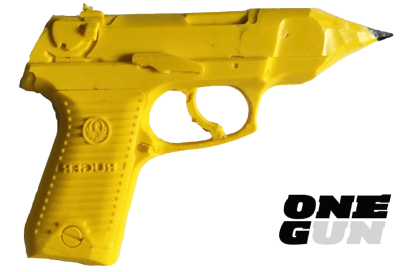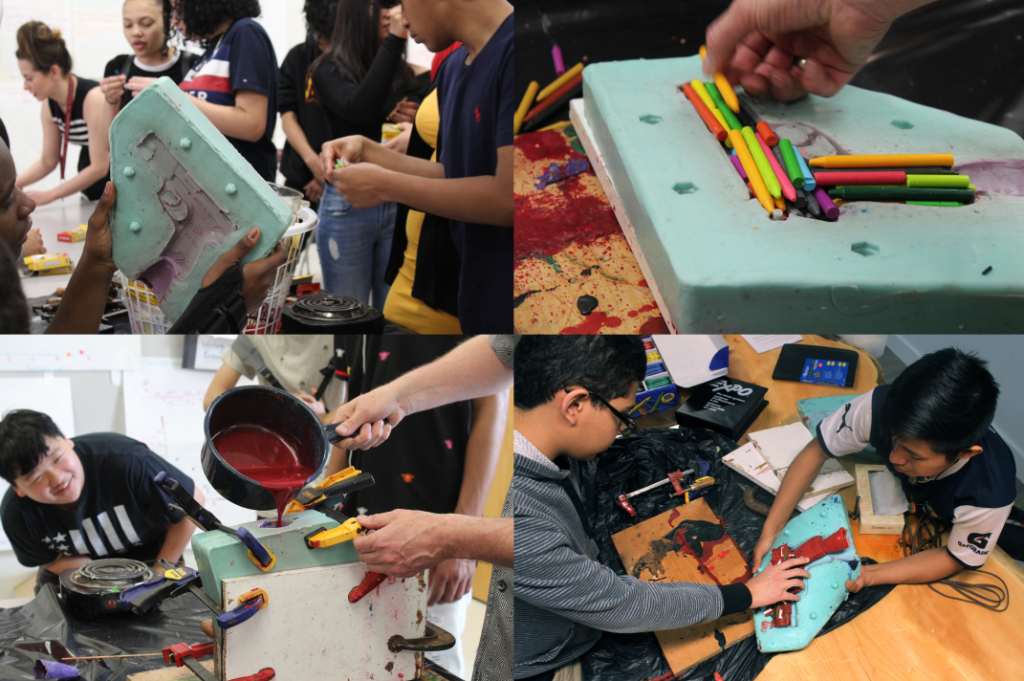In September 2015, Scott Lapham founded One Gun Gone as an art and engagement project to raise awareness about gun violence. A Providence-based fine art and commercial photographer and a teaching artist who is passionate about making art with young people, Scott had firsthand knowledge of the despair and destructiveness that gun violence brings to families and communities.
“I’ve been teaching youth from predominantly underserved communities for decades,” he says. “During that time, four of my students have been lost to gun violence. I’ve gotten an education in what gun violence has meant to me in my own life with people who I know. I wanted to have a positive response and to give students who experience it a voice.”
“I want my students to think of themselves not as residents of their communities but as citizens. This is an art project that has a very strong citizenship component to it.”
Students participating in the One Gun Gone project use a mold that Scott made from a decommissioned handgun to create art pieces for sale. They collaborate with other artists, offer workshops in schools and at youth organizations, and showcase their art in professional galleries. The money generated from the sale of all their artwork is dedicated to establishing a gun-buyback fund in Providence. Importantly, the project gives students — all in their mid-teens to early twenties — a nurturing, collaborative environment in which to discuss their feelings and develop their opinions about gun violence and its effects.
“I want my students to think of themselves not as residents of their communities but as citizens,” Scott says. “This is an art project that has a very strong citizenship component to it. I want my students to be proud of engaging in their own public life through this issue and others that they think are important. I try to provide opportunities for public speaking and to expose them to people, places, organizations, and careers that they might not encounter in their day-to-day lives.”
The SEG Network Effect
Scott heard about the SEG Impact Accelerator one day when he was having coffee with a friend who was also thinking about applying. The timing was perfect. “I was very excited to have an opportunity for professional development,” he says. “The SEG Accelerator was the type of opportunity I had been wanting for years and hadn’t encountered. I felt it would expose me to potential skill sets and ideas and concepts that I couldn’t quite put my finger on — what I didn’t know, but knew I didn’t know.”
“If I hadn’t come to SEG, I would still be doing what I’m doing, but I would not have the confidence that I do now. Now I know I’m using my energy wisely as opposed to wondering if I’m using my energy wisely.”
During his experience in the 2019 SEG Impact Accelerator, Scott had a number of aha moments. Many of them came as a result of conversations with his coach, Tereann Greenwood. “She understood very intuitively what this project was trying to do,” he says. “What she brought to the table was how to organize that and take the project to the next level. Her knowledge in helping nonprofits get to the next level was very good to hear when you haven’t had those conversations. Otherwise, it’s a lot of throwing something against the wall and seeing what works and feeling kind of blind. She really helped connect a lot of dots and clarify a lot of what was already happening in the project.”
Scott now has a concrete business plan for moving forward with One Gun Gone and has identified what he needs to do to grow his funding and sustainability. He has established a board of directors, has applied for nonprofit status, and has set up plans for increased marketing and fundraising. He is excited about using all the tools he acquired in the SEG Accelerator to deepen his impact and engagement with students and to support them as they become spokespeople and advocates raising awareness about gun violence.
“If I hadn’t come to SEG, I would still be doing what I’m doing, but I would not have the confidence that I do now,” he says. “Now I know I’m using my energy wisely as opposed to wondering if I’m using my energy wisely. And that’s because of the exercises, the conversations, the professional people I met. There are many different ways to make it as an artist, but there are also ways to spend a lot of energy without creating sustainability. I feel like there’s more potential for that now.”


